
Warbird Review: A List of Legendary Marine Aircraft
By: Barrett TillmanPosted on April 15, 2025
Executive Editor’s note: We fully realize that it’s a risky maneuver to create a list of the “best of” anything. Not everything could make the list; we’d love to hear from our readers about which aircraft would make your list.
Marine Corps aviation dates from 1912 when First Lieutenant Alfred Cunningham, the fifth Naval Aviator, was designated the Corps’ first pilot. Since then, “flying Leathernecks” have logged 113 years of service to the nation in a remarkable variety of aircraft.
Historically, Marine aviators have focused on supporting “the ground,” most notably in World War II, Korea and Vietnam. The symbiotic nature of that relationship probably was best illustrated at Guadalcanal where infantry protected Henderson Field while fighter and bomber squadrons countered the enemy at sea and ashore.
This subjective list of aircraft is based on historic significance to Marine Aviation, combat record and longevity of service. Most of the selections have passed into history, but the primary list and an honorable mention category include current aircraft such as the CH-53, F/A-18 Hornet, AV-8 Harrier and C-130 Hercules. For a look at which aircraft made our Honorable Mention list, check out page 67 in the May issue of Leatherneck.
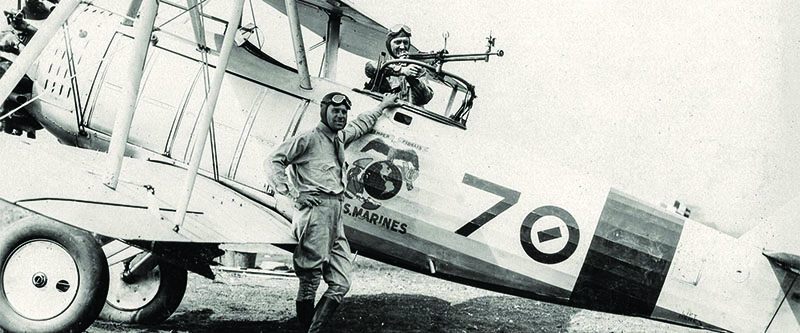
Vought O2U Corsair
For 75 years, Vought Aircraft in its many iterations provided naval aviation with everything from 90-knot biplanes to supersonic jets. Among the first was the O2U observation plane of 1927. Its wheels were removable for floats, enhancing the type’s versatility.
First Lieutenant Christian Schilt flew an O2U in his 1928 Medal of Honor actions in Nicaragua, though the aircraft’s public exposure peaked in the 1933 “King Kong” movie. Some 460 were built for U.S. plus export models, and the biplane was still in service at the time of the attack on Pearl Harbor.
Wingspan: 34 ft. 6 in.
Length: 24 ft. 8 in.
Height: 10 ft.
Wing Area: 337 sq. ft.
Engine: Pratt & Whitney R1340
425 hp radial
Maximum Weight: 3,600 lbs.
Maximum Speed: 151 mph
Service Ceiling: 22,500 ft.
Range: 580 statute miles
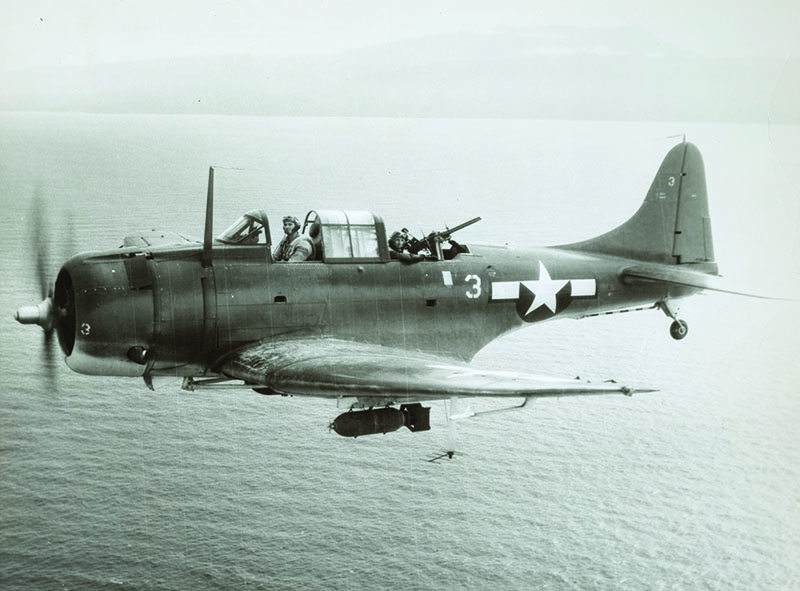
Douglas SBD Dauntless
Though considered obsolescent by 1942, the Dauntless carried the offensive load at Guadalcanal and points north. In fact, the Pacific War could not have been prosecuted with another scout-bomber, as the limited-production Vought SB2U proved inadequate and the Curtiss SB2C only arrived at the end of 1943.
Captain Richard Fleming was the only Marine dive bomber pilot awarded the Medal of Honor, as he perished at Midway.
The Corps continued flying SBDs until VJ Day, notably in the Central Pacific, plus the unique record of guarding the Sixth Army’s flank during the advance on Manila in 1945.
Wingspan: 41 ft. 6 in.
Length: 33 ft.
Height: 13 ft. 7 in.
Wing Area: 325 sq. ft.
Engine: Wright R-1820 radial, 1,200 hp
Maximum Weight: 10,700 lbs.
Maximum Speed: 255 mph
Service Ceiling: 22,500 ft.
Range: 1,400 statute miles
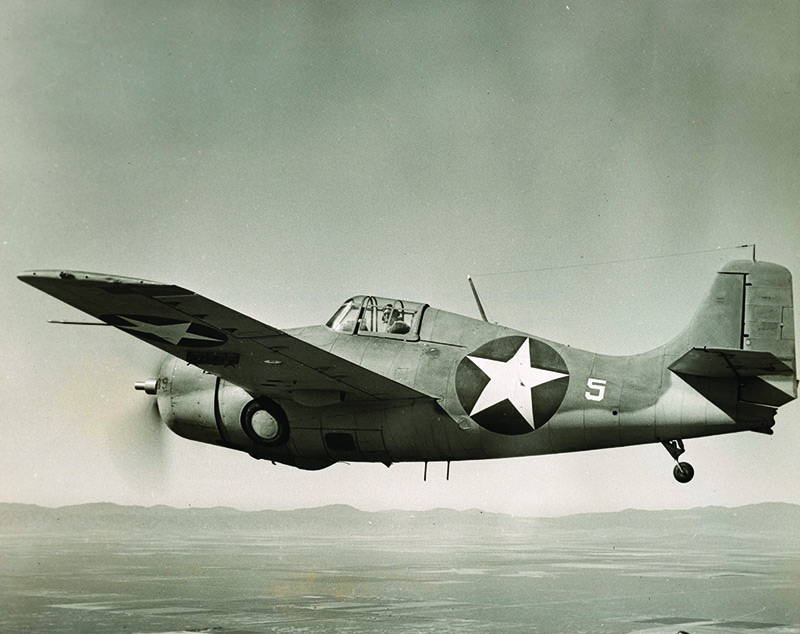
Grumman F4F Wildcat
From Wake Island onward, the Wildcat monopolized Marine fighter squadrons for the first 21 months of the Pacific War. Corsairs only began arriving in February 1943 and did not fully replace Wildcats until that summer.
When Secretary of the Navy Frank Knox famously said, “Grumman saved Guadalcanal,” he was referring to the F4F, though the TBF Avenger also contributed to that effort.
Seven Marines earned Medals of Honor in F4Fs: Henry Elrod, John L. Smith, Bob Galer, “Joe” Bauer, Joe Foss, Jeff DeBlanc and Jim Swett. Elrod died at Wake Island and Bauer disappeared near Guadalcanal.
Wingspan: 38 ft.
Length: 28 ft. 9 in.
Height: 11 ft. 10 in.
Wing area: 260 sq. ft.
Engine: Pratt & Whitney
R-1830 Twin Wasp
Maximum weight: 7,065 lbs.
Maximum speed: 330 mph
Service ceiling: 31,000 ft.
Range: 770 statute miles
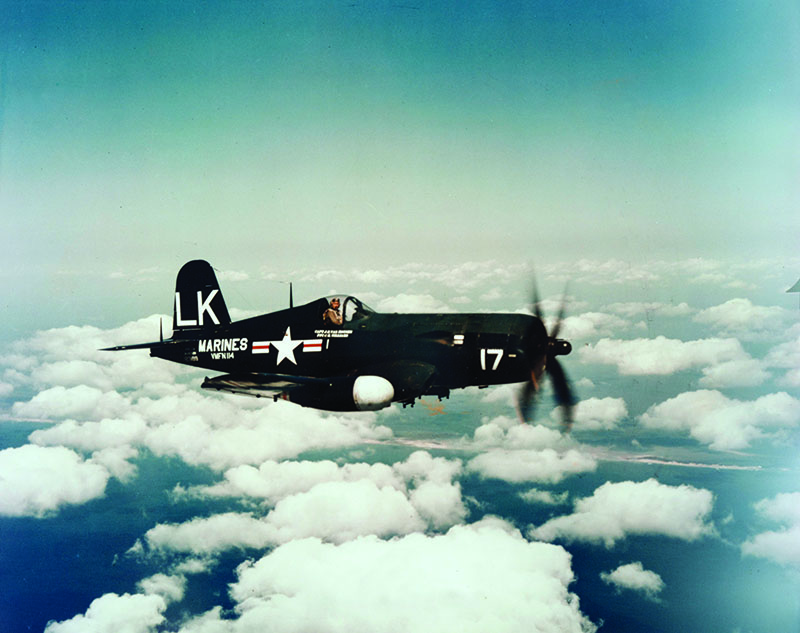
Vought F4F-4 Corsair
If any aircraft personifies Marine aviation, it remains Vought’s crank-winged F4U Corsair. Its iconic status remains due to VMF-214’s notoriety with Major Gregory Boyington. But from 1943 to 1945, the “U bird” flew with 35 other VMFs.
Contrary to legend, the Corsair was not kept off aircraft carriers because it was unsafe. The reason had more to do with sustaining two fighters in the fleet. However, in late 1944, the Kamikaze crisis brought Marines aboard carriers, augmenting Grumman F6F Hellcats.
At the start of the Korean War in June 1950, at least eight Marine squadrons flew F4U-4s plus two with F4U-5N night fighters. The last Reserve squadrons retired Corsairs in 1967.
Wingspan: 41 ft.
Length: 33 ft. 8 in.
Height: 14 ft. 9 in.
Wing area: 314 sq. ft.
Engine: 2,300 hp Pratt & Whitney R2800 radial
Maximum weight: 14,500 lbs.
Maximum speed: 446 mph
Service ceiling: 41,500 ft.
Range: 1,000 statute miles clean
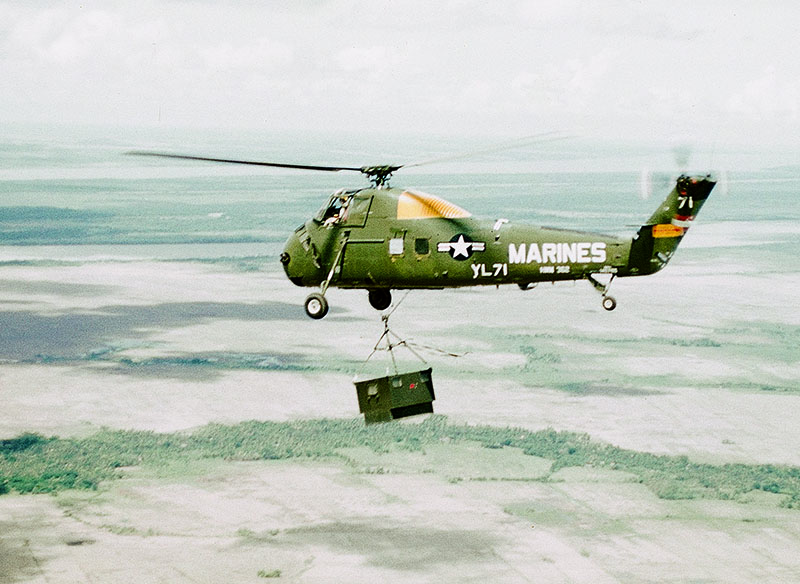
Sikorsky UH-34 Seahorse
The widely used UH-34 was variously called the Choctaw (Army), Seabat (Navy) and Seahorse (Marines). Usually leatherneck aircrews just said, “The 34” or referred to the ubiquitous D model as “The Dog.”
Powered by the same basic engine as the SBD, Sikorsky’s UH-34 personified Marine “in country” aviation during the Vietnam War. It was the Corps’ last piston-powered helicopter but remained in combat alongside Bell UH-1s and CH-46 Sea Knights until 1969. In his book “Dispatches,” correspondent Michael Herr wrote “The 34 had a lot of heart.” It remained in service until 1973.
Main rotor diameter: 56 ft.
Length: 45 ft. 9 in.
Height: 15 ft. 11 in.
Main rotor area: 2,463 sq. ft.
Engine: Wright R-1820 1,525 hp radial
Maximum Weight: 14,000 lbs.
Maximum Speed: 122 mph
Service Ceiling: 12,000 ft.
Range: 190 statute miles
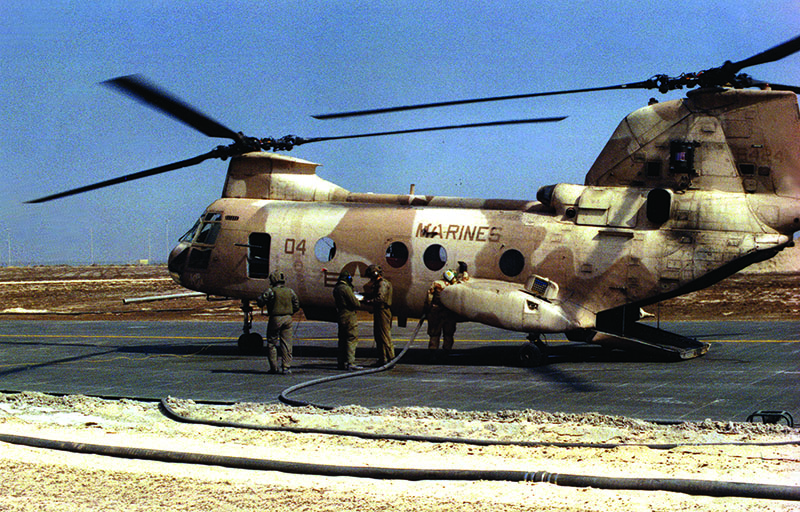
Boeing Vertol CH-46 Sea Knight
Originally the Sea Knight was designed by Vertol, then produced by Boeing. The first flight of the commercial version was in 1958, entering service in 1964 as a rare twin-turbine design. The twin rotors provided greater hover and lift capability.
The “Phrog” became a common sight in Vietnam, as it could carry 25 troops. But 109 were lost, more than any other Marine aircraft.
Production ended in 1971 with 524 for U.S. and foreign clients. It was best known to the public for evacuation of the embassy in Saigon, Vietnam, in 1975.
The CH-46 was used in Iraq and Afghanistan. The Marines retired it in 2015.
Rotor diameters: 55 ft.
Length: 44 ft. 10 in.
Height: 16 ft. 9 in.
Rotor Area: 3,900 sq. ft.
Engine: Two GE T58 turboshafts, 1,870 hp each
Maximum Weight: 24,300 lbs.
Maximum Speed: 166 mph
Service Ceiling: 17,000 ft.
Range: 690 statute miles
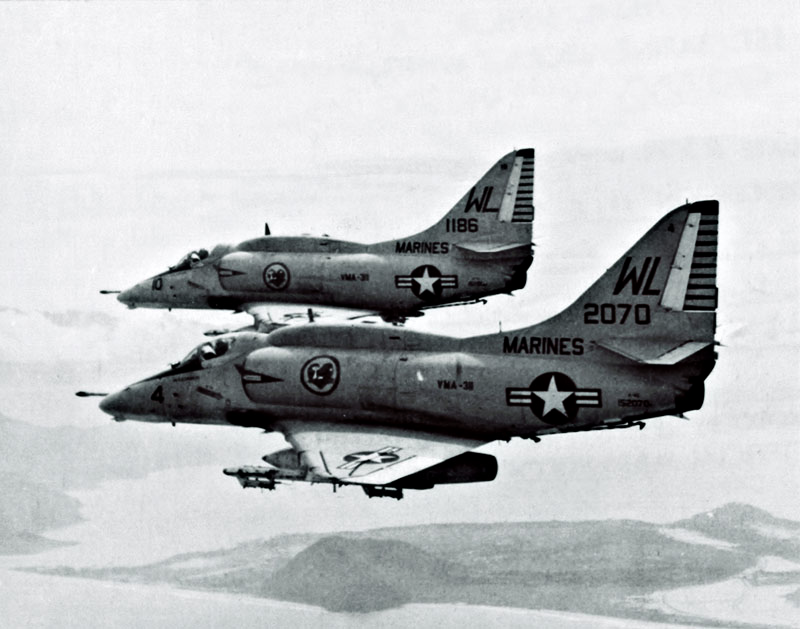
McDonnell Douglas A-4 Skyhawk
Designed as a subsonic attack jet, the long-lived A-4 was produced as single- and two-seaters. Originally cast as a nuclear delivery “platform,” the Skyhawk carved a niche for itself in Marine attack squadrons throughout the Vietnam War. About 80 were lost in Southeast Asia.
Douglas’ A-4 airframe proved rugged and durable, surviving battle damage in thousands of close air support sorties.
In all, more than 30 Marine operational, reserve and training squadrons flew the “Scooter.” The last Marine Skyhawks retired in 1998.
Wingspan: 27 ft. 6 in.
Length: 40 ft. 5 in.
Height: 15 ft. 2 in.
Wing Area: 260 sq. ft.
Engine: Pratt & Whitney
J51, 8,500 lbs. thrust
Maximum Weight: 16,200 lbs.
Maximum Speed: 673 statute mph
Service Ceiling: 40,000 ft.
Range: 1,100 statute miles
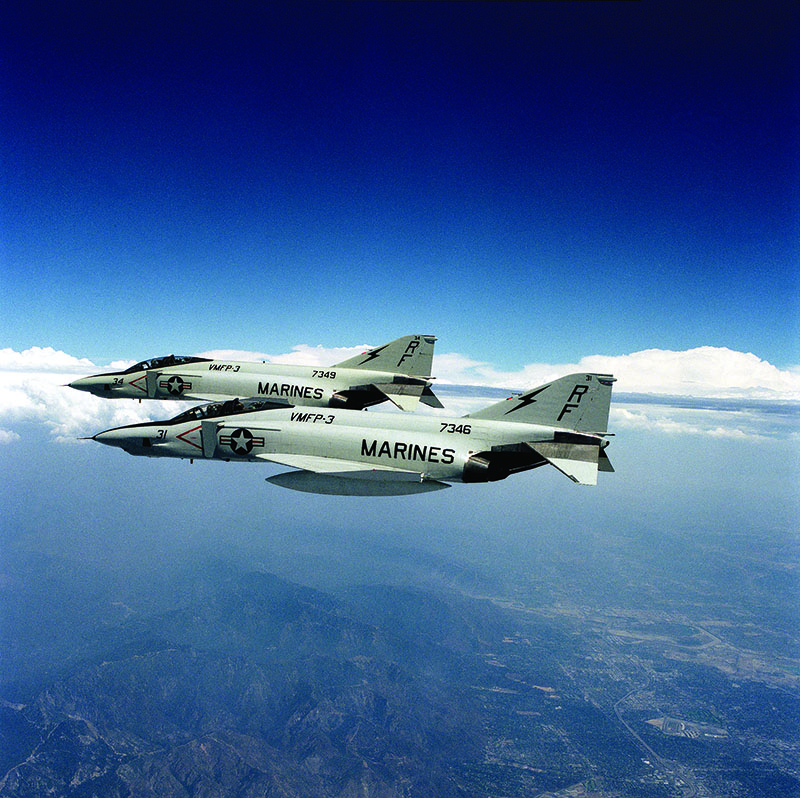
McDonnell Douglas F-4B Phantom II
Big, angular and imposing just sitting on the ramp, the Phantom exuded power and lethality. Its twin J79 afterburning engines drove the two-seater past Mach 2 in both fighter-bomber and reconnaissance versions.
With extraordinary ordnance capacity, the Phantom could loiter over forward air controllers “in contact” with enemy forces. Marine squadrons lost nearly 100 Phantoms in the Vietnam War.
The last Marine F-4s were retired in 1992, concluding a 30-year career. They were replaced by the same firm’s F/A-18 Hornets, which continue operating today.
Wingspan: 38 ft. 5 in.
Length: 63 ft.
Height: 16 ft. 5 in
Wing Area: 530 sq. ft.
Engines: Two General Electric J79s, 17,800 lbs. thrust
Maximum Weight: 41,500 lbs.
Maximum Speed: 1,470 mph (Mach 2.2)
Service Ceiling: 60,000 ft.
Range: 370 statute miles combat
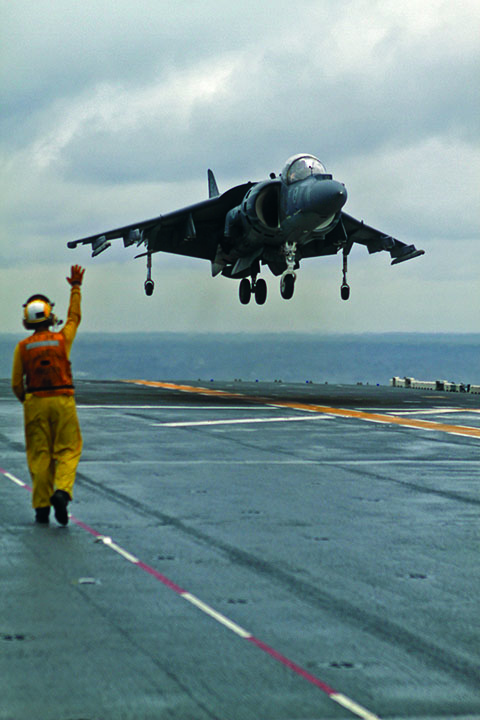
McDonnell Douglas AV-8 Harrier
Intended for expeditionary air support, the subsonic AV-8 Harrier was inspired by a British prototype from 1960. The Harrier’s single engine with thrust nozzles permits unmatched agility including vertical takeoffs and landings on ships as well as confined spaces ashore.
Marines obtained AV-8As in 1971, and the B model in 1985.
AV-8s have been flown by eight operational squadrons and a dedicated training unit. In 2024, two squadrons retained Harriers, and earlier this year, “AV-8-tors” were shooting down Houthi drones threatening shipping in the Red Sea.
Wingspan: 30 ft. 4 in.
Length: 46 ft. 4 in.
Height: 11 ft. 1 in.
Wing Area: 243 sq. ft.
Engine: Rolls-Royce Pegasus turbofan, 23,500 lbs. thrust
Maximum Weight: 22,900 lbs.
Maximum Speed: 673 mph
Service Ceiling: 50,000 ft. plus
Range: 1,400 statute miles
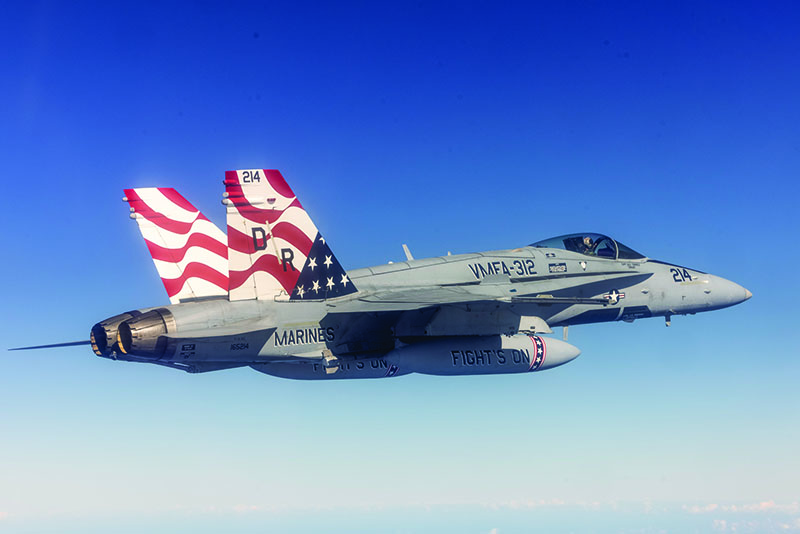
McDonnell Douglas FA-18 Hornet
The Hornet arose from a Navy requirement for a lower cost replacement for the F-14 Tomcat. Designated F/A-18 for fighter-attack, it first flew in 1978 and entered service in 1983-1984 with the larger, more capable FA-18E/F Super Hornet debuting in 2001.
Two-seat Hornets with a naval flight officer are better able to perform strike missions than single-seaters, with enhanced night capability.
As of 2024, six squadrons still flew Hornets during transition to the F-35B vertical takeoff and F-35C conventional carrier versions.
Wingspan: 40 ft. 4 in.
Length: 56 ft. 1 in.
Height: 15 ft. 5 in.
Wing Area: 410 sq. ft.
Engines: Two GE F404 turbofans, 17,750 lbs. thrust
Maximum Weight: 36,900 lbs.
Maximum Speed: 1,190 mph (Mach 1.8)
Service Ceiling: 50,000 ft. plus
Range: 1,250 statute miles clean




